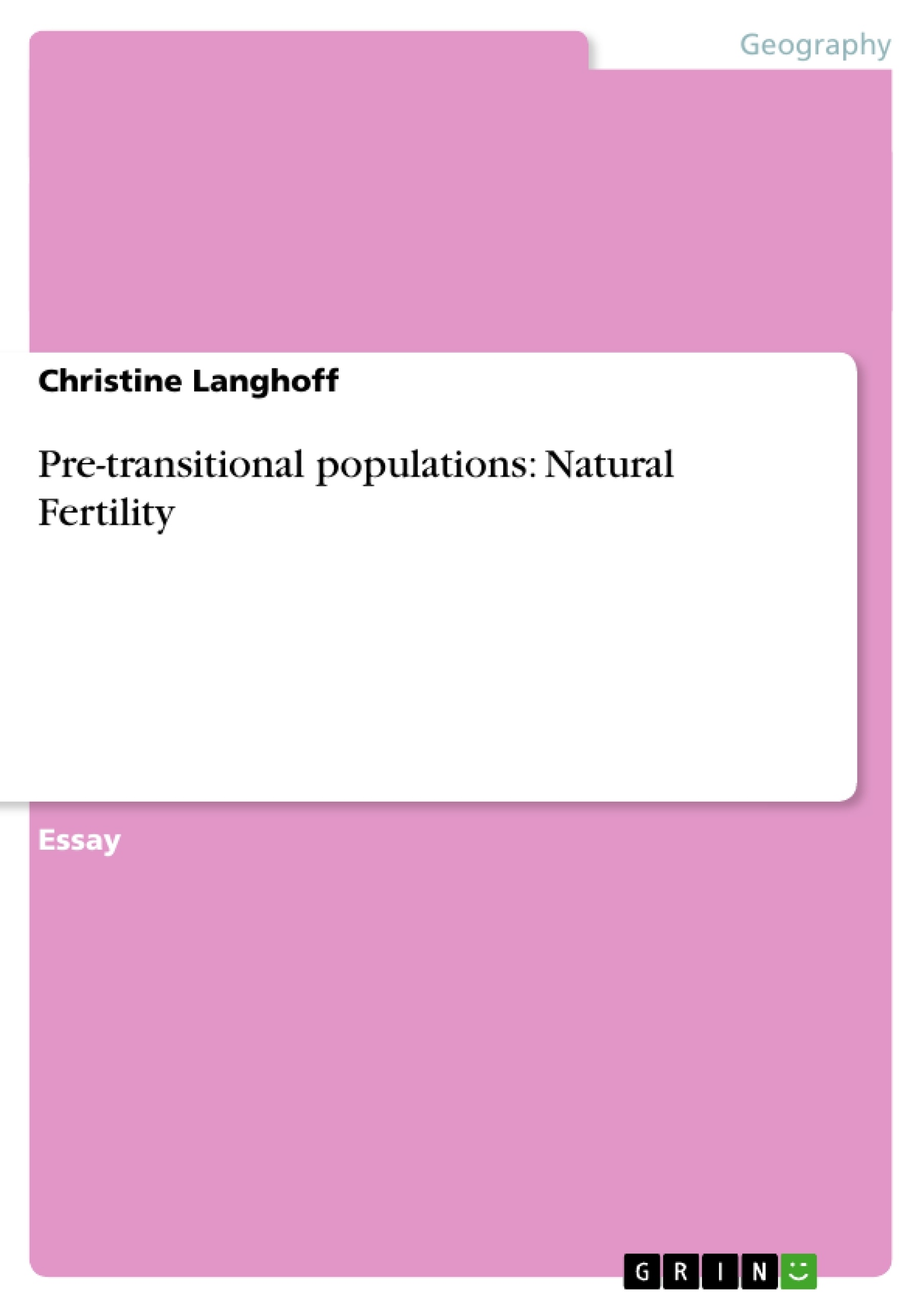Excerpt
2. Pre-Transitional Populations II: Natural Fertility
Fertility is directly determined by so-called intermediate fertility variables or proximate determinants which are, in turn, affected by indirect determinants such as socio-economic, cultural and environmental variables. Many different proximate determinants influence fertility and the relationship between them and the level of fertility can be analysed using a comprehensive model. The result of this analysis shows that variations in four factors – marriage, contraception, lactation and induced abortion – are the primary proximate causes of fertility differences among populations. While fertility variations can always be traced to variations in one or more of the intermediate variables, the scope for variation differs among the variables as does their degree of influence in different societies and over time within societies.
In classical demographic transition theory it was assumed that pre-transitional societies were characterised by uniformly high fertility rates, which provided the starting point for the recent secular decline in fertility. Most ecological anthropologists, in contrast, have come to believe that many traditional societies, especially unacculturated hunter-gatherers, have regulated their reproductive output at relatively low levels. It has even been suggested that there occurred an earlier, stone-age demographic transition toward higher birth rates associated with the emergence of settled village life during the Neolithic. Two recent studies reveal differences between the total fertility rate (TFR) of hunter-gatherers (foragers) (5.7 and 5.6) and agriculturalists (6.3 and 6.6). Henry used the phrase “natural fertility populations” to describe pre-transitional societies. The term “natural fertility” applies to a population in which couples do not practice deliberate fertility control dependent on the number of children they have. Practices that are independent of parity (number of children ever born) are considered to be natural fertility factors. This concept is controversial and difficult to apply as natural fertility is influenced by many different indirect and direct determinants. The full force of social controls on the speed of human reproduction can be clearly appreciated when we contrast reproductive potential with realised levels of fertility. Although the calculation of potential fertility, or fecundity, is beset with conceptual, technical and measurement problems, a consensus has emerged that for most human populations, the upper limit on the average number of live births per woman must lie between 13 and 17. For a population an acceptable average number of births per woman is around 15.3. Even this number of births can only be achieved by a rare combination of circumstances due to the many proximate determinants involved in determining fertility, thus measured levels of “natural” marital fertility rarely surpass 11 or 12 live births.
The following simple diagram summarises the relationships among the determinants of fertility:
Abbildung in dieser Leseprobe nicht enthalten
environmental variables
This diagram clearly shows that if any factor is to affect fertility, it must do so via its effects on one or more of the proximate determinants.
The following proximate determinants have been proposed to have effects on natural fertility:
I. Exposure factors
1. Proportion of women married or in sexual unions at each age
2. Proportion of women postmenarchal at each age
3. Proportion of women premenopausal at each age
II. Susceptibility factors
4. Duration of lactational infecundability
5. Fecund waiting time to conception (fecundability factors)
(a) frequency of the follicular phase
(b) ovarian cycle length
(i) length of the follicular phase
(ii) length of the luteal phase
(c) proportion of cycles ovulatory
(d) duration of the fertile period, given ovulation
(e) probability of conception from a single insemination in the fertile period
6. Prevalence of pathological sterility
7. Frequency of spontaneous intrauterine mortality
8. Length of gestation
Contraception and induced abortion are two further proximate determinants that are very important and their absence implies the existence of natural fertility. It has to be noted that the process of modernisation can have fertility-promoting effects through many of these variables. As mentioned above, while fertility variations can always be traced to variations in one or more of the intermediate variables, the scope for variation differs among the variables as does their degree of influence in different societies and over time within societies. Bongaarts has constructed a set of equations for measuring the influence of the intermediate fertility variables on fertility in different settings.
Demographers have long recognised marriage as one of the principal proximate determinants of fertility. In most societies women spend substantial proportions of their potential reproductive years out of marriage, either before first marriage or after a marriage has ended due to divorce, separation, or death of the husband. In addition, some women never marry. A quantitative assessment of the fertility effect of different marriage patterns can be made using the following indexes:
TFR: total fertility rate, equal to the number of births a woman would have a t the end of her reproductive years if she were to bear children at prevailing age-specific fertility rates while living throughout the reproductive period (excluding illegitimate births but based on all women of reproductive age whether married or not)
TM: total marital fertility rate, equal to the number of births a woman would have at the end of the reproductive years if she were to bear children at prevailing age-specific marital fertility rates and to remain married during the entire reproductive period (based on the fertility of married women aged 15-45)
Cm: index of proportion married (this is calculated as the weighted average of the age-specific proportions married, with the weights given by the age-specific marital fertility rate)
[...]
- Quote paper
- BA (Oxon), Dip Psych (Open) Christine Langhoff (Author), 2002, Pre-transitional populations: Natural Fertility, Munich, GRIN Verlag, https://www.grin.com/document/4696
Publish now - it's free






















Comments